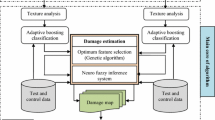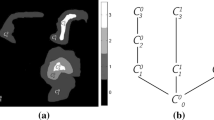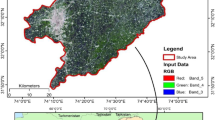Abstract
In this paper, we implemented and evaluated the proposed method for building detection and classification using high-resolution imagery (IKONOS) data. Nagapattinam province of Tamil Nadu, which was strongly attacked by the 2004 Indian Ocean tsunami, is selected as the demonstration site. IKONOS sets acquired on June 10, 2003, (pre-tsunami)–December 29, 2004, (post-tsunami) are used in this study. This approach follows the standard scheme of image analysis: building detection, feature extraction and selection, and classification. At the first level, we studied the damaged buildings from imagery data set. In the second level, 28 texture features and 3 spectral features are extracted, and then 10 best features are selected for next stage by using the statistical dependency feature selection method. In the classification, the proposed method feature mean ratio is used to classify the damaged buildings. The proposed method has been applied on an IKONOS imagery in Nagapattinam city, and visual validation demonstrates that the proposed method provides promising results. The results proved that the proposed work has produced a higher accuracy assessment (96.4%) when compared to earlier works.





Similar content being viewed by others
References
Arai, K. (2013). Remote sensing satellite image database system allowing image portion retrievals utilizing principal component which consists spectral and spatial features extracted from imagery data. International Journal of Advanced Research in Artificial Intelligence, 2(5), 32–38.
Blaschke, T. (2010). Object based image analysis for remote sensing. ISPRS Journal of Photogrammetry and Remote Sensing, 65(1), 2–16.
Clausi, D. A. (2002). An analysis of co-occurrence texture statistics as a function of grey level quantization. Canadian Journal of Remote Sensing, 28(1), 45–62.
Guyon, I., Weston, J., Barnhill, S., & Vapnik, V. (2002). Gene selection for cancer classification using support vector machines. Machine Learning, 46, 389–422.
Haralick, R. M., Shanmugam, K., & Dinstein, I. (1973). Textural features for image classification. IEEE Transactions on Systems, Man and Cybernetics, 6, 610–621.
Hermosilla, T., Ruiz, L. A., Recio, J. A., & Cambra-López, M. (2011). Efficiency of context-based attributes for land-use classification of urban environments. International Archieves of the Photogrammetry, Remote Sensing and Spatial Information Sciences, 3819, 105–110.
Ilsever, M., & Unsalan, C. (2012). ‘Two-dimensional change detection methods’, remote sensing applications. Berlin: Springer.
Jain, Y. K., & Bhandare, S. K. (2011). Min max normalization based data perturbation method for privacy protection. International Journal of Computer & communication Technology, 2(8), 45–50.
Kalra, K., Goswami, A. K., & Gupta, R. (2013). A comparative study of supervised image classification algorithms for satellite images. International Journal of Electrical, Electronics and Data Communication, 1, 10–16.
Kodituwakku, S. R., & Selvarajah, S. (2010). Comparison of color features for image retrieval. Indian Journal of Computer Science and Engineering, 1(3), 207–211.
Koshimura, S., Matsuoka, M., Gokon, H., & Namegaya, Y. (2010). Searching tsunami affected area by integrating numerical modeling and remote sensing. In IEEE international geoscience and remote sensing symposium (pp. 3905–3908).
Kumaraperumal, R., Natarajan, S., Sivasamy, R., Chellamuthu, S., Ganesh, S. S., & Anandakumar, G. (2007). Impact of tsunami 2004 in coastal villages of Nagapattinam district, India. Science of Tsunami Hazards, 26, 93.
Kurugollu, F., Sankur, B., & Harmanci, A. H. (2001). Color image segmentation using histogram multithresholding and fusion. Image and Vision Computing, 19(13), 915–928.
Laws, K.I. (1985). Goal-directed texture image segmentation. In Applications of artificial intelligence II, SPIE (vol. 548, pp. 19–26).
Miura, H., Midorikawa, S., & Soh, H. -C. (2012). Building damage detection of the 2010 Haiti earthquake based on texture analysis of high-resolution satellite images. In 15th World Conference on Earthquake Engineering (15WCEE) (vol. 14, pp. 10703–10711). LISBOA.
Navalgund, R. R. (2005). Sumatra tsunami of december 26, 2004. Journal of the Indian Society of Remote Sensing, 33(1), 1–6.
Ojala, T., Pietikainen, M., & Maenpaa, T. (2002). Multiresolution grey-scale and rotation invariant texture classification with local binary patterns. IEEE Transactions on Pattern Analysis and Machine Intelligence, 24(7), 971–987.
Preetha, J., & Jayandhi, G. (2014). Detection of pulmonary nodules using MTANN in chest radiographs. International Journal of Emerging Technology and Advanced Engineering, 4(2), 241–246 (ISO 9001:2008 Certified Journal).
Preeti, A. K. (2014). Colour image segmentation using K-means, fuzzy C-means and density based clustering. International Journal for Research in Applied Science and Engineering Technology (IJRASET), 2, 31–35.
Raina, S. T., Kumari, D., & Gupta, D. (2012). An approach for image noise identification using minimum distance classifier. International Journal of Scientific & Engineering Research, 3(4), 1–4.
Ramesh, B., & Kumar, J. S. (2003). Cloud detection and removal algorithm based on mean and hybrid methods. International Journal of Computing Algorithm, 02(01), 121–126.
Reddy, B. S., & Chatterji, B. N. (1996). An FFT-based technique for translation, rotation and scale-invariant image registration. IEEE Transactions on Image Processing, 5(8), 1266–1271.
Sathya, P., & Malathi, L. (2011). Classification and segmentation in satellite imagery using back propagation algorithm of ANN and K-means. International Journal of Machine Learning and Computing, 1, 422.
Shorter, N., & Kasparis, T. (2009). Automatic vegetation identification and building detection from a single nadir aerial image. Remote Sensing, 1(4), 731–757.
Soh, L. K., & Tsatsoulis, C. (1999). Texture analysis of SAR sea ice imagery using gray level co-occurrence matrices. IEEE Transactions on Geoscience and Remote Sensing, 37(2), 47.
Stein, E., Bachmann, M., Heldens, W., Müller. A., & Schmullius C. (2009a). A spectral feature based classification algorithm for characterisation of urban surfaces in Munich. In Imaging spectroscopy SIG workshop.
Stein, E., Bachmann, M., Heldens, W., Müller, A., & Schmullius, C. (2009b). A spectral feature based classification algorithm for characterization of urban surfaces in Munich. In 6th EARSeL-SIG-IS, 16.-18. März, Tel Aviv, Israel.
Stoppiglia, H., Dreyfus, G., Dubois, R., & Oussar, Y. (2003). Ranking a random feature for variable and feature selection. Journal of Machine Learning Research, 3, 1399–1414.
Sutton, R. N., & Hall, E. L. (1972). Texture measures for automatic classification of pulmonary disease. IEEE Transactions on Computers, 21(7), 667–676.
Trinder, J.C., & Salah, M. (2012). Aerial images and lidar data fusion for disaster change detection, The University of New South Wales.
Author information
Authors and Affiliations
Corresponding author
About this article
Cite this article
Merlin, G.S., Jiji, G.W. Building Damage Detection of the 2004 Nagapattinam, India, Tsunami Using the Texture and Spectral Features from IKONOS Images. J Indian Soc Remote Sens 47, 13–24 (2019). https://doi.org/10.1007/s12524-018-0858-z
Received:
Accepted:
Published:
Issue Date:
DOI: https://doi.org/10.1007/s12524-018-0858-z




